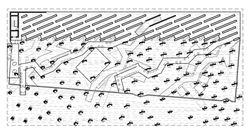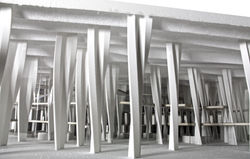 |  |  |  |  |
|---|---|---|---|---|
 |  |  |  |  |
 |
WARPED & WEFTED
A LIBRARY OF COLUMNS
2015
Columns provide an effect that is different than other vertical elements. They are vectors rather than a surfaces (walls) or volumes. However, as vector components, they can array to create perceptual surfaces and volumes which may be understood differently from varying viewpoints, appearing porous from one direction and impermeable in another.
When arrayed, columns have the ability to control views and direct the occupants’ perception of the space. As seen in the hypostyle halls of Ancient Egypt or Eisenman’s Berlin memorial, columns only allow fragments of the space to be observed at any one time. While these examples direct the space through the size of column and density of array, by manipulating the columns’ form and their distribution within the field similar effects can be achieved using other techniques.
When columns are distributed in a grid, there are two axes of transparency. As seen in the previous examples, these axes form visual aisles through the space that change as the viewer moves through the array. In order to create an anisotropic space, with only one axis of view, the field has to become non-gridded, apparently random in distribution. The field loses all directional attributes and in response, the columns’ form becomes responsible for creating the directional grain of the space.
Because the field doesn’t have discernible axes, the columns provide the spatial grain and visual orientation. Varying the form of the columns throughout their height allows the grain of the space to change from bottom to top, even as the columns remain vertical. If the grain twists 90 degrees from bottom to top, it creates a field that appears compressed, tall, lifted, or opaque depending on the direction from which it is viewed. Aligning other building elements with the shifting grain is essential to maintaining the effects generated.
The organization of the building as a whole responds to and extends the optics of the columnar field. At the front of the building, a loggia allows the sculpture garden to extend into the site at the ground level. The grain of the columns creates continuity through the building to an outdoor court at the north of the site. At the upper level, the grain operates transversely, connecting the Broad Plaza to the west with the trees on Charles Young Dr. to the east.
As columns take on the grain, they become thin plates. Taking this plate and folding it creates many advantages. First, it stabilizes the plate structurally. Second, it thickens the plate’s profile from oblique views, helping to maintain transparency through the array in one direction while increasing opacity in others. Third, adjusting the folds creates a system of variation that can accommodate different types of program, folding to creating individual workstations, expanding to become wall like and create privacy, or compressing to create transparency. Lastly, the folds create an optical effect that helps multiple columns blend together. As each column takes on a vertically banded rhythm, it helps to blur the boundaries between columns. Because of this, when viewed on the oblique the columns are seen as a single wall rather than a series of individual objects.
As the largest component of the program, the collections are organized in a bar at the back of the space. This allows the majority of the column filled space to remain a single, open volume. The stacks align with the grain of the field at each level, twisting as they move from bottom to top. This allows the collections to be condensed while still maintaining the field’s transparency through the building. Additional stacks are distributed throughout the ground floor along with study spaces that utilize the unique form of the columns. Within the field, additional volumes are suspended to contain specific program elements, also implying spaces below them. These volumes are reached through a series of catwalks that branch out from the wall of books, also maintaining the grain of each level. As the catwalks snake through the columns, they reveal aisles through the field that are otherwise invisible and exist only on one level. From these floating aisles, viewers are immersed in the shifting grain, free to find the study location that best fits them.